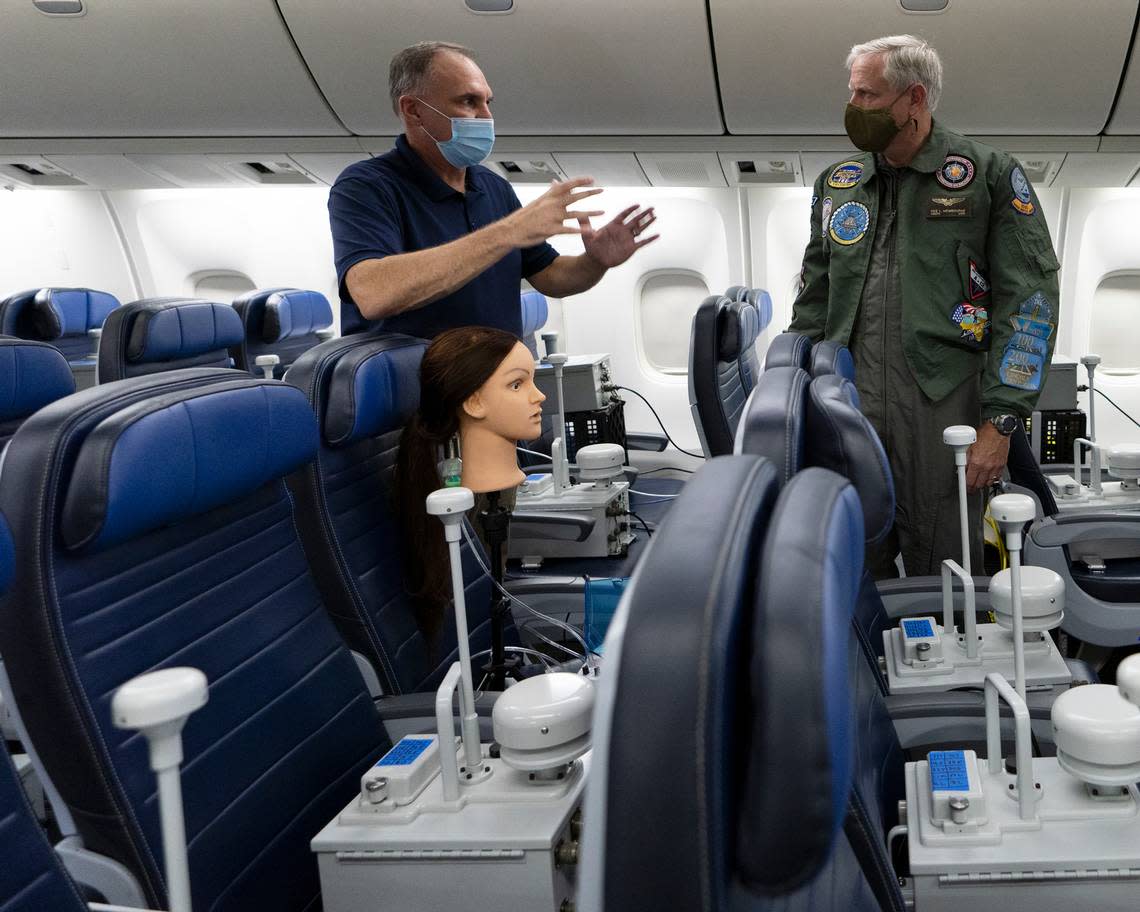Military study finds airline passengers unlikely to spread COVID if they wear a mask

During a long flight, if a passenger behind you coughs, how much risk do you face of catching coronavirus?
A new study by U.S. Transportation Command, headquartered at Scott Air Force Base, found that the exposure risk may be small — especially if everyone wears a mask.
Researchers from Transportation Command and the Defense Advanced Research Projects Agency (DARPA) conducted 300 tests with mannequins and sensors aboard United Airlines 767 and 777 wide-body jets.
“No one has generated this level of understanding of aerosol movement in aircraft,” said DARPA scientist Eric Van Gieson. “Now there is a dataset out there that the commercial and private industry can utilize.”
The Pentagon sought the study to determine what the safest seat configurations were for its global transport flights of troops and their families.
In the tests, aerosols with fluorescent tracers were released to map the circulation of air particles during breathing. In some tests, a mannequin, representing an infected passenger, would release a “cough” of aerosol particles that were detected by the sensors. In some of the tests the mannequin wore a mask, in others, it didn’t.
The greatest exposure occurred for passengers seated on the same row, and in the rows immediately behind and in front of the mannequin.
But even with those passengers, the sensors detected that the saturation of particles had dropped off by as much as 99 percent by the time they traveled to those seats. That finding lead TRANSCOM’s researchers to conclude that passengers would have to be in the aircraft for more than two days with an infected person to absorb a high enough level of COVID particles to become ill.
The mannequin was moved around to different seats in the aircraft to see where the particles would spread.
The tests, which were conducted in August, did not look at “large droplet” transmission, for example, if a person spoke without a mask on, moved around the cabin without a mask, or took the mask off to eat.
The researchers found that when the mannequin wore a mask, 95 percent of the particles were blocked.
When there was no mask, however, the spread of the aerosol particles still only traveled to a smaller area of people than expected.
“The analysis showed an overall low exposure risk on aircraft from airborne pathogens like COVID-19,” said Vice Adm. Dee Mewbourne, deputy commander of Transportation Command.
The Centers for Disease Control and Prevention reported in September that 1,600 passengers it had studied who had flown while infected with COVID may have exposed as many as 11,000 passengers to the virus, but the CDC also said it was not able to verify that those additional passengers had become exposed because of the flight.
The Transportation Command study found that, depending on where the “infected” mannequin was located, there were very slight differences in exposure levels recorded between a passenger who sat on the aisle, versus a middle seat or window.
Overall, the different levels of exposure were so miniscule for aisle or window seats that “there is no practical difference at these high overall reduction levels.”
One of the key factors in reducing the travel of the particles was use of the plane’s air filtration systems.
“Keeping air supply and recirculation mode (HEPA-Filtration) operating is critical,” the study said, recommending that all aircraft have the filtration systems on during boarding.
The study also recommended that based on its findings, wider contact tracing of the entire passenger manifest may not be necessary just because an infected passenger flew on an airline.
However, it found that contact tracing may be necessary “for large droplet transmission in the seats immediately neighboring an infectious passenger, or from uncertainty in human behavior, such as “talking to a neighboring passenger while eating or drinking without a mask.”

